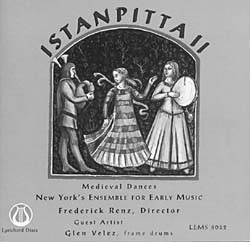![[Metroactive Music]](/music/gifs/music468.gif)
![[Metroactive Music]](/music/gifs/music468.gif)
[ Music Index | Metro | Metroactive Central | Archives ]
More Than 'Amore'
New CDs reveal a wealth of diverse Italian music
By Sam Prestianni
MANY AMERICANS know Italy through Hollywood-style images of the Mafia and the pope. There's little that is contemporary in our collective imaginings of la Italia. The music programmed for last year's Italian Festa in the East Bay underscores this point. Amid mounds of pasta and casks of Chianti, accordionists squeezed out familiar tunes and Italian-American chestnuts like "That's Amore" and "Volare." Trite as it is, this kind of revelry makes for innocuous family entertainment, but it also unintentionally perpetuates cultural stereotypes, as if to say there has been no notable progression in Italian music in the decades since Al Martino's chart-topping love song or that only a melody co-opted for an automobile commercial is worthy of popular performance on the festival circuit. Over the past year or so, a handful of labels have aspired to remedy this situation. Recordings ranging from 14th-century dances to genre-bending innovations by Enzo Lanzo, Mario Schiano and E Zezi reveal a tremendous cultural heritage relatively unknown in the U.S. Volumes I and II of Istanpitta (Lyrichord), directed by Frederick Renz of New York's Ensemble for Early Music, resuscitate 600-year-old Italian melodies on period instruments such as bagpipes, hammered dulcimer, lute and transverse flute. The hypnotic rhythms and Old World embellishments evoke mood swings right out of Shakespeare's Verona. "Saltarello," a tune popularized a few years back on Dead Can Dance's Aion (4AD), the centerpiece of the first installment, should appeal not only to fans of world music and medieval traditions but to progressive aficionados as well.
Shadow, Light (Hemisphere) documents cutting-edge rock artist Franco Battiato's 180-degree transformation into a spiritually absorbed composer whose meditative soundtracks skirt the margins of classical, world and New Age music. Though influenced by Indian and Middle Eastern beliefs, Battiato can't escape his Catholic roots. He combines a choral presentation of the "Archaic Mass" ("Kyrie," "Gloria," etc.) with a minimal blend of strings, keyboards and piano. Granted, this album rides on the coattails of the recent chant craze, and its ultraserene synthetic wash will surely vex acoustic purists, but there's something riveting in the sincerity of Battiato's vision.
RECONCILING the vagaries of the flesh with the strictures of the church is the dominant paradox in Italian culture. Master drummer Enzo Lanzo boldly points this out on Rondonella Project (Leo Lab), his epic improvisational jazz retelling of the story of folk heroine Rondonella, an enchanting woman whose uninhibited sexuality inflamed the passions of a repressed early-20th-century village. Rondonella's struggle for freedom parallels that of Lanzo and his avant-garde compatriot Mario Schiano, celebrated actor and principal alto saxophonist in the notorious Italian Instabile Orchestra.
Even though they rank among Italy's leading improvisers, Lanzo and Schiano must constantly vie for respect (and work) with the jazz establishment. Social Security (Victo), Schiano's latest collaboration with Instabile bandmate Sebi Tramontana and U.K. heavyweights Evan Parker, Barry Guy and Paul Lovens, embodies the journeyman's spirit of liberation in an extended four-part improvisation that serves as a heady reminder that America has no monopoly on creative jazz.
On Pummarola Black (Lyrichord), E Zezi exemplifies the diverse influences and revolutionary zeal at the heart of cutting-edge contemporary Italian music. Smashed glasses, the chaotic chatter of the marketplace and an infectious ebullience that swings between rallying bullhorn shouts and wine-drunk New Year's celebration give their songs a mad dramatic flavor akin to that in a Fellini film. Breathless forward momentum, pitch-and-reel folk melodies and a wild combination of references (from African to Xiavante Indian to European Gypsy) transform all traces of the familiar into something unprecedented. Scathing indictments of "toilet" government and despotic corporations, like Maserati, culminate in a boisterously satirical finale: "All Hail to the Red, White & Blue." The tune segues into a guttural rap complete with heavy funk beat and wah-wah guitar, making it clear that all preconceptions have been obliterated. Yet, in the end, a vitality that at first seems curiously off-kilter comes across as utterly Italian--as Italian as, well, as pasta and Chianti.
[ Metro | Metroactive Central | Archives ]
This page was designed and created by the Boulevards team.


From the February 27-March 5, 1997 issue of Metro
Copyright © 1997 Metro Publishing, Inc.